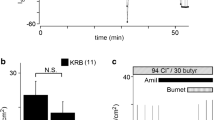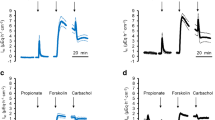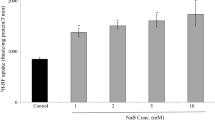Abstract
The aim of this study was to investigate the putative influence of some pharmacological agents and drugs of abuse upon the apical uptake of butyrate (BT) into Caco-2 cells. The apical uptake of 14C-BT by Caco-2 cells was (1) time and concentration dependent, (2) pH dependent, (3) Na+ independent and Cl− dependent, (4) energy dependent, (5) inhibited by several BT structural analogues (acetate, propionate, α-ketobutyrate, pyruvate, lactate), (6) insensitive to the anion exchange inhibitors DIDS and SITS and (7) inhibited by the monocarboxylate transport (MCT) inhibitors NPPB and pCMB. These characteristics are compatible with an involvement of MCT1-mediated transport. Acutely, uptake of a low concentration of 14C-BT (10 μM) was reduced by acetaldehyde, acetylsalicylic acid, indomethacin, caffeine and theophylline and increased by MDMA. Chronically, uptake was increased by caffeine and decreased by tetrahydrocannabinol and MDMA; reverse transcription quantitative real-time PCR analysis showed that these three compounds decreased the mRNA levels of MCT1. Acutely, acetaldehyde, indomethacin and MDMA reduced the uptake of a high concentration of 14C-BT (20 mM), and acetylsalicylic acid increased it. Chronically, none of the compounds affected uptake. Acetaldehyde, indomethacin and propionate seem to be competitive inhibitors of 14C-BT uptake. Acetylsalicylic acid simultaneously increased the K m and the V max of 14C-BT uptake. In conclusion, MCT1-mediated transport of 14C-BT in Caco-2 cells is modulated by either acute or chronic exposure to some pharmacological agents and drugs of abuse (acetaldehyde, acetylsalicylic acid, indomethacin, caffeine, theophylline and the drugs of abuse tetrahydrocannabinol and MDMA).








Similar content being viewed by others
References
Ahmed FE (2004) Effect of diet, life style, and other environmental/chemopreventive factors on colorectal cancer development, and assessment of the risks. J Environ Sci Health C Environ Carcinog Ecotoxicol Rev 22:91–147
Alrefai WA, Tyagi S, Gill R, Saksena S, Hadjiagapiou C, Mansour F, Ramaswamy K, Dudeja PK (2004) Regulation of butyrate uptake in Caco-2 cells by phorbol 12-myristate 13-acetate. Am J Physiol Gastrointest Liver Physiol 286:G197–G203
Araújo JR Gonçalves P, Martel F (2008) Modulation of glucose uptake in a human trophoblast cell line (BeWo) by dietary bioactive compounds and drugs of abuse. J Biochem 144:177–186 doi:10.1093/jb/mvn054
Binder HJ, Mehta P (1989) Short chain fatty acids stimulate Na and Cl absorption in vitro in the rat distal colon. Gastroenterology 96:989–996
Bingham SA, Day NE, Luben R et al (2003) Dietary fibre in food and protection against colorectal cancer in the European Prospective Investigation into Cancer and Nutrition (EPIC): an observational study. Lancet 361:1496–1501
Borthakur A, Gill RK, Hodges K et al (2006) Enteropathogenic Escherichia coli inhibits butyrate uptake in Caco-2 cells by altering the apical membrane MCT1 level. Am J Physiol Gastrointest Liver Physiol 290:G30–G35
Borthakur A, Saksena S, Gill RK et al (2008) Regulation of monocarboxylate transporter 1 (MCT1) promoter by butyrate in human intestinal epithelial cells: involvement of NF-kappaB pathway. J Cell Biochem 103:1452–1463
Bradford MM (1976) A rapid method for the quantitation of microgram quantities of protein utilizing the principle of protein-dye binding. Anal Biochem 72:248–254
Burkitt DP (1971) Epidemiology of cancer of the colon and rectum. Cancer 28:3–13
Buyse M, Sitaraman SV, Liu X et al (2002) Luminal leptin enhances CD147/MCT-1-mediated uptake of butyrate in the human intestinal cell line Caco2-BBE. J Biol Chem 277:28182–28190
Cassidy A, Bingham SA, Cummings JH (1994) Starch intake and colorectal cancer risk: an international comparison. Br J Cancer 69:937–942
Chan TA (2002) Nonsteroidal anti-inflammatory drugs, apoptosis, and colon-cancer prevention. Lancet Oncol 3:166–174
Choi JS, Jin MJ, Han HK (2005) Role of monocarboxylic acid transporters in the cellular uptake of NSAIDs. J Pharm Pharmacol 57:1185–1189
Coady MJ, Chang MH, Charron FM et al (2004) The human tumour suppressor gene SLC5A8 expresses a Na+-monocarboxylate cotransporter. J Physiol 557:719–731
Cuendet M, Pezzuto JM (2000) The role of cyclooxygenase and lipoxygenase in cancer chemoprevention. Drug Metabol Drug Interact 17:109–157
Cuff MA, Shirazi-Beechey SP (2004) The importance of butyrate transport to the regulation of gene expression in the colonic epithelium. Biochem Soc Trans 32:1100–1102
Cuff MA, Lambert DW, Shirazi-Beechey SP (2002) Substrate-induced regulation of the human colonic monocarboxylate transporter, MCT1. J Physiol 539:361–371
Cuff M, Dyer J, Jones M et al (2005) The human colonic monocarboxylate transporter isoform 1: its potential importance to colonic tissue homeostasis. Gastroenterology 128:676–686
Cummings JH (1981) Short chain fatty acids in the human colon. Gut 22:763–779
Daly K, Cuff MA, Fung F et al (2005) The importance of colonic butyrate transport to the regulation of genes associated with colonic tissue homeostasis. Biochem Soc Trans 33:733–735
Delie F, Rubas W (1997) A human colonic cell line sharing similarities with enterocytes as a model to examine oral absorption: advantages and limitations of the Caco-2 model. Crit Rev Ther Drug Carr Syst 14:221–286
Elbashir SM, Harborth J, Lendeckel W et al (2001) Duplexes of 21-nucleotide RNAs mediate RNA interference in cultured mammalian cells. Nature (London) 411:494–98
Ganapathy V, Gopal E, Miyauchi S et al (2005) Biological functions of SLC5A8, a candidate tumour suppressor. Biochem Soc Trans 33:237–240
Gibson PR, Moeller I, Kagelari O et al (1992) Contrasting effects of butyrate on the expression of phenotypic markers of differentiation in neoplastic and non-neoplastic colonic epithelial cells in vitro. J Gastroenterol Hepatol 7:165–172
Greenhough A, Patsos HA, Williams AC et al (2007) The cannabinoid delta(9)-tetrahydrocannabinol inhibits RAS-MAPK and PI3K-AKT survival signalling and induces BAD-mediated apoptosis in colorectal cancer cells. Int J Cancer 121:2172–2180
Gupta N, Martin PM, Prasad PD et al (2006) SLC5A8 (SMCT1)-mediated transport of butyrate forms the basis for the tumor suppressive function of the transporter. Life Sci 78:2419–2425
Hadjiagapiou C, Schmidt L, Dudeja PK et al (2000) Mechanism(s) of butyrate transport in Caco-2 cells: role of monocarboxylate transporter 1. Am J Physiol Gastrointest Liver Physiol 279:G775–G780
Hague A, Elder DJ, Hicks DJ et al (1995) Apoptosis in colorectal tumour cells: induction by the short chain fatty acids butyrate, propionate and acetate and by the bile salt deoxycholate. Int J Cancer 60:400–406
Hamer HM, Jonkers D, Venema K et al (2008) Review article: the role of butyrate on colonic function. Aliment Pharmacol Ther 27:104–119
Harig JM, Ng EK, Dudeja PK et al (1996) Transport of n-butyrate into human colonic luminal membrane vesicles. Am J Physiol Gastrointest Liver Physiol 271:G415–G422
Heerdt BG, Houston MA, Augenlicht LH (1994) Potentiation by specific short-chain fatty acids of differentiation and apoptosis in human colonic carcinoma cell lines. Cancer Res 54:3288–3293
Higdon JV, Frei B (2006) Coffee and health: a review of recent human research. Crit Rev Food Sci Nutr 46:101–23
Howe GR, Benito E, Castelleto R et al (1992) Dietary intake of fiber and decreased risk of cancers of the colon and rectum: evidence from the combined analysis of 13 case-control studies. J Natl Cancer Inst 84:1887–96
Itagaki S, Gopal E, Zhuang L et al (2006) Interaction of ibuprofen and other structurally related NSAIDs with the sodium-coupled monocarboxylate transporter SMCT1 (SLC5A8). Pharm Res 23:1209–1216
Kawai N, Tsujii M, Tsuji S (2002) Cyclooxygenases and colon cancer. Prostaglandins Other Lipid Mediat 68–69:187–196
Kawamata K, Hayashi H, Suzuki Y (2007) Propionate absorption associated with bicarbonate secretion in vitro in the mouse cecum. Pflugers Arch 454:253–62
Keating E, Lemos C, Azevedo I et al (2006) Characteristics of thiamine uptake by the BeWo human trophoblast cell line. J Biochem Mol Biol 39:383–393
Keating E, Lemos C, Gonçalves P et al (2008) Acute and chronic effects of some dietary bioactive compounds on folic acid uptake and on the expression of folic acid transporters by the human trophoblast cell line BeWo. J Nutr Biochem 19:91–100
Kim YI (2000) AGA technical review: impact of dietary fiber on colon cancer occurrence. Gastroenterology 118:1235–1257
Kripke SA, Fox AD, Berman JM et al (1989) Stimulation of intestinal mucosal growth with intracolonic infusion of short-chain fatty acids. J Parent Enter Nutr 13:109–116
Lambert DW, Wood IS, Ellis A et al (2002) Molecular changes in the expression of human colonic nutrient transporters during the transition from normality to malignancy. Br J Cancer 86:1262–1269
Lecona E, Olmo N, Turnay J et al (2008) Kinetic analysis of butyrate transport in human colon adenocarcinoma cells reveals two different carrier-mediated mechanisms. Biochem J 409:311–320
Lemos C, Peters GJ, Jansen G et al (2007) Modulation of folate uptake in cultured human colon adenocarcinoma Caco-2 cells by dietary compounds. Eur J Nutr 46:329–336
Mascolo N, Rejendran VM, Binder HJ (1991) Mechanism of short-chain fatty acid uptake by apical membrane vesicles of rat distal colon. Gastroenterology 101:331–338
Maubon N, Le Vee M, Fossati L, Audry M, Le Ferrec E, Bolze S, Fardel O (2007) Analysis of drug transporter expression in human intestinal Caco-2 cells by real-time PCR. Fundam Clin Pharmacol 21:659–663
McNeil NI, Cummings JH, James WP (1979) Rectal absorption of short chain fatty acids in the absence of chloride. Gut 20:400–403
Medina V, Edmonds B, Young GP et al (1997) Induction of caspase-3 protease activity and apoptosis by butyrate and trichostatin A (inhibitors of histone deacetylase): dependence on protein synthesis and synergy with a mitochondrial/cytochrome c dependent pathway. Cancer Res 57:3697–3707
Michels KB, Willett WC, Fuchs CS et al (2005) Coffee, tea, and caffeine consumption and incidence of colon and rectal cancer. J Natl Cancer Inst 16:282–292
Monteiro R, Calhau C, Martel F et al (2005) Intestinal uptake of MPP+ is differently affected by red and white wine. Life Sci 76:2483–2496
Montrose MH, Kere J (2001) Anion absorption in the intestine: anion transporters, short chain fatty acids, and role of the DRA gene product. Curr Top Membr Transp 50:301–928
Mortensen PB, Clausen MR (1996) Short-chain fatty acids in the human colon: relation to gastrointestinal health and disease. Scand J Gastroenterol 216:132–148
Mosmann T (1983) Rapid colorimetric assay for cellular growth and survival: application to proliferation and cytotoxicity assays. J Immunol Methods 65:55–63
Muzyka A, Tarkany O, Yelizanof V et al (2005) Non-linear regression (curve fit). GraphPad Prism for Windows. San Diego, CA.
Park Y, Hunter DJ, Spiegelman D et al (2005) Dietary fiber intake and risk of colorectal cancer: a pooled analysis of prospective cohort studies. JAMA 294:2849–2857
Pöschl G, Seitz HK (2004) Alcohol and cancer. Alcohol Alcohol 39:155–165
Resta-Lenert S, Trung F, Barrett KE et al (2001) Inhibition of epithelial chloride secretion by butyrate: role of reduced adenylyl cyclase expression and activity. Am J Physiol Cell Physiol 281:C1837–C1849
Ritzhaupt A, Eliis A, Hosie KB et al (1998) The characterization of butyrate transport across pig and human colonic luminal membrane. J Physiol 507:819–830
Roda A, Simoni P, Magliulo M et al (2007) A new oral formulation for the release of sodium butyrate in the ileo-cecal region and colon. World J Gastroenterol 13:1079–1084
Roediger WE (1980) Role of anaerobic bacteria in the metabolic welfare of the colonic mucosa in man. Gut 21:793–798
Roediger WE (1982) Utilization of nutrients by isolated epithelial cells of the rat colon. Gastroenterology 83:424–429
Sakata T, von Engelhardt W (1983) Stimulatory effect of short-chain fatty acids on the epithelial cell proliferation in rat large intestine. Comp Biochem Physiol 74A:459–462
Scheppach W, Bartram P, Richter A et al (1992a) Effect of short-chain fatty acids on the human colonic mucosa in vitro. J Parenter Enteral Nutr 16:43–48
Scheppach W, Sommer H, Kirchner T et al (1992b) Effect of butyrate enemas on the colonic mucosa in distal ulcerative colitis. Gastroenterology 103:51–55
Seitz HK, Homann N (2007) The role of acetaldehyde in alcohol-associated cancer of the gastrointestinal tract. Novartis Found Symp 285:110–119, discussion 119–4, 198–9
Shiff SJ, Koutsos MI, Qiao L et al (1996) Nonsteroidal antiinflammatory drugs inhibit the proliferation of colon adenocarcinoma cells: effects on cell cycle and apoptosis. Exp Cell Res 222:179–188
Stein J, Zores M, Schroeder O (2000) Short-chain fatty acid (SCFA) uptake into caco-2 cells by a pH-dependent and carrier mediated transport mechanism. Eur J Nutr 39:121–125
Tamai I, Takanaga H, Maeda H et al (1995) Participation of a proton-cotransporter, MCT1, in the intestinal transport of monocarboxylic acids. Biochem Biophys Res Commun 214:482–489
Tavani A, La Vecchia C (2004) Coffee, decaffeinated coffee, tea and cancer of the colon and rectum: a review of epidemiological studies, 1990–2003. Cancer Causes Control 15:743–757
Thibault R, De Coppet P, Daly K et al (2007) Down-regulation of the monocarboxylate transporter 1 is involved in butyrate deficiency during intestinal inflammation. Gastroenterology 133:1916–1927
Trock B, Lanza E, Greenwald P (1990) Dietary fiber, vegetables, and colon cancer: critical review and meta-analyses of the epidemiologic evidence. J Natl Cancer Inst 82:650–661
Vernia P, Monteleone G, Grandinetti G et al (2000) Combined oral sodium butyrate and mesalazine treatment compared to oral mesalazine alone in ulcerative colitis: randomized, double-blind, placebo-controlled pilot study. Dig Dis Sci 45:976–981
Whitehead RH, Young GP, Bhathal PS (1986) Effects of short chain fatty acids on a new human colon carcinoma cell line (LIM1215). Gut 27:1457–1463
Wong JMW, Souza R, Kendall CWC et al (2006) Colonic health: fermentation and short chain fatty acids. J Clin Gastroenterol 40:235–243
Acknowledgements
This work was supported by Fundação para a Ciência e a Tecnologia (FCT) and Programa Ciência, Tecnologia e Inovação do Quadro Comunitário de Apoio (PTDC/SAU-FCF/67805/2006). The authors wish to thank Prof. Isabel Azevedo for the revision of the manuscript.
Author information
Authors and Affiliations
Corresponding author
Rights and permissions
About this article
Cite this article
Gonçalves, P., Araújo, J.R., Pinho, M.J. et al. Modulation of butyrate transport in Caco-2 cells. Naunyn-Schmied Arch Pharmacol 379, 325–336 (2009). https://doi.org/10.1007/s00210-008-0372-x
Received:
Accepted:
Published:
Issue Date:
DOI: https://doi.org/10.1007/s00210-008-0372-x




